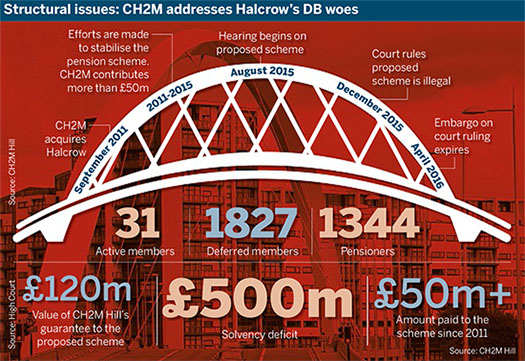Halcrow plots rescue of DB scheme
Engineering company Halcrow’s pension scheme is expected to agree a liability-management exercise in coming weeks after the High Court ruled a previous proposal was illegal.
Unruly defined benefit liabilities can wreak havoc on the finances of the sponsoring employer and significantly complicate their operations. The challenges faced by Tata Steel and BHS are just two examples in the past few weeks.
Engineering giant CH2M acquired Halcrow in September 2011, but discovered the company was in a more distressed state than initially thought.
Once you have a pension scheme deficit it is incredibly difficult to make an adjustment to anything to get it under control
At the time of acquisition, the value of the scheme liabilities was estimated to be about £100m. On December 31 2015 Towers Watson calculated the solvency deficit was approximately £500m, a spokesperson from CH2M said. The High Court, however, said in December last year the figure was £600m.
Claire Southern, partner at law firm Hogan Lovells, who represented Halcrow*, said: “They thought they had a better business than they acquired, and then the liabilities moved south.”**
Halcrow has paid more than £50m into the scheme since the acquisition, but around £500m would still be needed to secure the benefits.
Southern added: “It underlines the importance of knowing what you’re buying. Once you have a pension scheme deficit it is incredibly difficult to make an adjustment to anything to get it under control.”
Rescue attempts
To prevent members entering the PPF the trustees and employer agreed on a proposed mirror scheme, providing identical benefits to members and having the same trustees, but pensions would increase at the statutory level rather than the guaranteed 5 per cent previously offered.
In a letter to members, the trustees and company said: “The trustees and Halcrow agreed to pursue this option as they concluded, having taken extensive legal, actuarial, accounting and employer covenant advice, it was in the best interests of members of the Halcrow Pension Scheme to move into the new scheme. This was because the new scheme would provide members with better benefits than the PPF and would benefit from a direct guarantee from CH2M.”
However, the High Court ruled in December 2015 the proposed scheme could not be implemented, as pensions legislation stated members could not be transferred between schemes without giving individual consent.
At the judgement, Mrs Justice Asplin said: “It is clear to me that the trustees undertook a careful and proper review of all the relevant issues and took full and proper professional advice… Had I taken a different view in relation to the legal issues, I would have approved the trustee’s decision to enter the transaction.”
A spokesperson for law firm Sackers, who represented the trustees, said: “The Halcrow trustees have worked hard in difficult circumstances to protect their members’ interests. They took extensive advice and ultimately agreed to a proposal they believed to be in the best interest of members.”
Historic legislation
The spokesperson added that part of the proposal involved seeking the High Court’s ruling on the application of the preservation regulations, “legislation that came into existence some 25 years ago, at a very different time for defined benefit pension schemes”.
The trustees and Halcrow are now working on an alternative solution, which Southern said was “designed to get to a place where everyone has an outcome that works for them”.
A spokesperson for CH2M said: “The financial position of Halcrow is a matter of public record. Since acquisition, material contributions have been made to the Halcrow pension schemes to improve their funding levels and tackle the deficits in place at acquisition.”
The spokesperson added: “CH2M and Halcrow continue to look for consensual ways to improve the funding position of the pension schemes.”
*An earlier version of this article said Claire Southern represented CH2M, the parent company of Halcrow. This has now been amended.
**Update: Following publication of this article, Southern provided the following additional commentary: "Even though due diligence was carried out it goes to show how external factors such as low interest rates and increased longevity can impact a liability. It is never possible to fully predict the rate at which a liability can grow.”
Most Viewed
- What does Labour have in store for the pensions industry?
- Dashboard costs rose by 23% in 2023, figures show
- LGPS latest: GLIL backers invest £475m for UK infrastructure push
- Border to Coast launches UK strategy in major private markets push
- How the pensions industry can better support people with mental health problems


